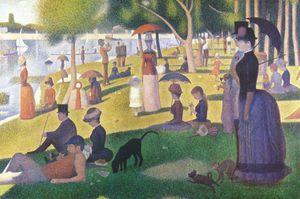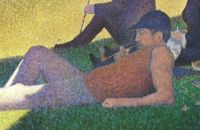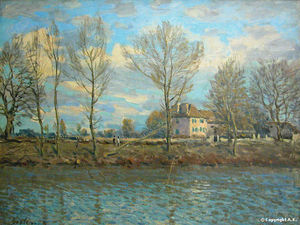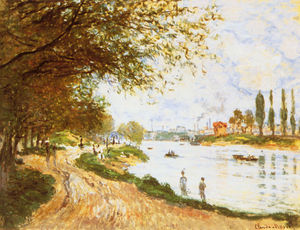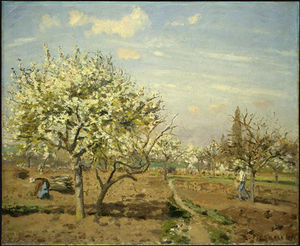A Sunday Afternoon on the Island of La Grande Jatte
- Date of Creation:
- 1886
- Alternative Names:
- A Sunday Afternoon on La Grande Jatte
- Height (cm):
- 200.00
- Length (cm):
- 600.00
- Medium:
- Oil
- Support:
- Canvas
- Subject:
- Scenery
- Technique:
- Pointillism
- Characteristics:
- Mural sized
- Art Movement:
- Impressionism
- Created by:
- Current Location:
- New York, New York
- Displayed at:
- Museum of Modern Art
- A Sunday Afternoon on the Island of La Grande Jatte Page's Content
- Story / Theme
- Inspirations for the Work
- Analysis
- Critical Reception
- Related Paintings
- Artist
- Art Period
- Bibliography
A Sunday Afternoon on the Island of La Grande Jatte Story / Theme
The 'Ile de la Grande Jatte' translates as 'Big Bowl Island' and the immense work by Georges Seurat perfectly depicts it's character. The island itself is a mile long and located on the Seine in the Neuilly-sur-Seine department of Paris and represented a high class get away for the Parisian community. Seurat's
In its remote location Seurat was able to capture an interesting glimpse of wealthy Parisian life in the 19th century. The painting sparked numerous interpretations and was criticized for being too mathematical. Upon its exhibition however, it was mostly heralded as a grand work of meticulous proportions.
Seurat's style of painting broadly diverged from his school and upon leaving it he decided to travel to the Island of La Grande Jatte. It was here that he was to find the inspiration for his landmark work of art and cement his reputation as an artist forever.
The planning and cast of Grande Jatte was notoriously as complex as the work itself and Seurat went through many sketched drafts before he arrived on the final plan for the painted piece. The cast comprised three dogs, eight boats and 48 people as they congregated for a Sunday afternoon in the sunny park.
Seurat's work included a wide range of characters including; boaters, soldiers, the young and old and people of varying classes of dress. The planning stage of Seurat's masterpiece involved 28 drawings, 28 panels and three larger canvases. Some sections of his work required extra care and attention to detail and had specific pre-planning studies, such as the seated women in the foreground.
Seurat started his project in May of 1884 and intended it to be exhibited at the Salon des Indépendants of 1885 but the exhibition was cancelled. The change in plans meant that Seurat went back to add details to the work and these mainly consisted of his most recent thoughts on color and its use in paintings. Seurat also changed the shapes of some of his figures in order to create more sinuous rhythms.
A Sunday Afternoon on the Island of La Grande Jatte Story was eventually exhibited in the eighth Impressionist exhibition of May 1886.
Where exactly Seurat painted Grande Jatte is a subject of much discussion since its completion. The picturesque content of the piece has also been brought into the question because it is painted at a spot on the island which doesn't incorporate any of the increasingly apparent industry that had begun appearing on the island.
Despite the island of La Grande Jatte looking a great deal different to how it once did, Seurat's effort is perhaps the most similar to how it looks today. The banks of the river Seine are considerably steeper than in Seurat's day but one spot is convincingly similar to his Grande Jatte.
A Sunday Afternoon on the Island of La Grande Jatte Inspirations for the Work
Pointillism and Grammaire des arts au dessin (1867) by Charles Blanc:
Grammaire was a book formed from ideas on color that first stemmed from figures such as Michel Eugéne Chevreul, David Sutter and Ogden Rood. The scientists were able to put into easily understandable theories about color, perception and optical effects that were first formulated by legendary scientists Isaac Newton and Helmholtz.
Grammaire was a version of such treatises in terms that were easier for artists to understand and upon reading it, it was said to have had a notable influence on Seurat and his work on Grand Jatte. Blanc's work was said to make reference to styles and techniques, which could have and eventually did have a direct application for Grande Jatte.
The island of La Grande Jatte:
In his formative years Seurat's artistic direction differed greatly from his school, the Ecole des Beaux-Arts. As a direct result the artist broke away from the school and headed to La Grande Jatte to live for a brief period.
On the banks of the river Seine, the island represented a new type of modernity for leisure for some of Paris' wealthier citizens. The island inspired Seurat to paint perhaps the most notorious work of his short-lived career.
A Sunday Afternoon on the Island of La Grande Jatte Analysis
Composition:
Seurat's balance is carefully positioned and proportioned so that the entire work is interesting to look at. The river to the left is full of yachts and rowing boats, while this balance is matched by the closely placed large figures to the right.
In the center of the work is a flurry of activity, which makes the painting's center as appealing to look at as the left and the right. Despite the activity in the piece, however, the artist's placing of his figures lends a degree of formality and static to his piece.
His decision to only depict people facing sideways or straight on makes the entire scene seem very rigid and like toy soldiers, which was a criticism leveled against the artist at the time.
Color palette:
Seurat utilizes this blending technique through his use of shadows. In traditional painting, shadows are primarily represented by the color black. Following the principles of pointillism, Seurat is able to define his shadows by the color that they come into contact with. The skirts of the women provide the best examples for this. The clothing of the women in the center of the piece seems to be casting a blue shadow on the ground. Seurat's shadows here are not being defined by traditional means but are instead a combination of the colors in its proximity.
Here the mix of green provides a blue shadow, which does not follow the conventions of shadow casting. Such a different approach in the creation of shadows is repeated in the dress of the woman on the right. Where the mix of light and green casts a yellow halo for the trees the same effect is mimicked here. The woman's dress creates a slight yellow line before the onset of the shadow and this yellow hue can be seen particularly towards the back of her skirt.
Furthermore, the shadow of her dress is a slight shade of blue as Seurat's green grass dots intermingle with the dress' blue and purple dots.
Use of light:
Seurat's use of light is one of the unique points of the piece. The work is vibrantly portrayed and the magnificence of the sun bathes the scene's inhabitants in a celestial mid-afternoon glow.
Where the technique of pointillism shows its unique aspect is where the light from the left comes into contact with people and objects in the piece. The blend of such colors is pointillism's primary concern and as its founder Seurat's work epitomizes the technique.
The tree line at the top of the painting is one example of such a blended effect. The luminous bright white day to the upper left section of the piece steadily becomes less and less white until it blends seamlessly with the vibrant greens of the trees leaves. Seurat's technique means that such tiny dots of white are placed next to dots of green until the relevant effect is actualized.
The mix of white and green creates a halo like yellow in parts before it turns fully into green. Seurat's technique in this regard directly matches the color wheel which influenced his work immeasurably. Here the color green blends into the color yellow as the lightest color on the wheel.
Perspective:
Most of the figure's view is focused on the river to the left of the image. Despite the river comprising of only a small part of the painting, its busy portion draws the viewer's gaze. The figures at the front are also very close to the viewer, making the woman's dress in the front of the piece purposefully enlarged. Her and the man walking with her are the biggest figures in a painting of immense proportions and their size balances this work.
A Sunday Afternoon on the Island of La Grande Jatte Critical Reception
As with many bold new artistic movements or styles pointillism was regarded with a great deal scorn upon its exhibition. The painting style was like nothing that had come before it and much of the general public and art critics viewed it negatively view.
A Sunday Afternoon on the Island of La Grande Jatte was the first painting of its kind to be painted entirely in the pointillism style and it was on the frontline with regards to both the advancement of Georges Seurat's new painting technique and the Impressionist movement as a whole.
Contemporary critical reception:
Upon the exhibition of Grande Jatte in 1886, it was the single most notorious canvas among all of the exhibited pieces. The eighth impressionist exhibition prided itself on being at the cutting edge of new styles and movements and thus Seurat's Grande Jatte stood out. The work received heavy criticism, centered on the artist's mathematical, robotic interpretations of Paris modernity.
Posthumous reception:
Notable Marxist historian and philosopher Ernest Bloch was one of the forerunners of drawing social and political significance from Georges Seurat's Grande Jatte. The historian's focal point was Seurat's robotic use of the figures and what their static nature said about French society at the time. Bloch's view of the piece is perhaps best summarized in his book 'The Principle of Hope'.
Modern day critical reception:
Modern day opinions of Seurat's work seem to concur in parts with Bloch's view of the work. In her work Seurat's Grande Jatte: An Anti-Utopian Allegory Linda Nochlin highlights the lack of interaction between Seurat's figures and argues that Seurat's work is explicitly political in its content.
By making the figures lacking any uniqueness or articulation Seurat has undermined the traditional concept of Western depiction. Here there is no meaning to be interpreted, story to be actualized or hidden meaning to be discovered. Nochlin also notes that Seurat's choice of dots over stroke is a representation of the mechanical nature of the piece.
A Sunday Afternoon on the Island of La Grande Jatte Related Paintings
A Sunday Afternoon on the Island of La Grande Jatte Artist
Georges Seurat was aged 27 when he painted the most influential work of his career. Grand Jatte was Seurat's first major work and took a place of prominence at the eighth Impressionist exhibition, where it was first exhibited.
The artist was said to have been inspired the local splendor of the island and dedicated two years of his life to bringing the mural sized work to completion. Grande Jatte itself is completed in Seurat's trademark pointillist technique, which emphasizes the purity of color on the canvas. His technique is boldly realized in the piece and its large bright form garnered the artist a great deal of acclaim and notoriety.
A Sunday Afternoon on the Island of La Grande Jatte Art Period
Many critics have noted that Georges Seurat's Grand Jatte came at a time when the Impressionist movement was in grave need of new inspiration. Seurat's monumental work was exhibited in the eighth Impressionist exhibition and among talents such as Lucien and Camille Pissarro. Like Seurat such artists were also followers of divisionism, but Seurat's Grand Jatte stood out in the exhibition as the most notorious artwork.
Seurat's work on Grand Jatte and his other Impressionist pieces would breath new life into the Impressionist movement and eventually spark the artistic movement known as Neo-Impressionism.
A Sunday Afternoon on the Island of La Grande Jatte Bibliography
For further insight into the life and works of Georges Seurat, please refer to the following recommended sources.
• Broude, Norma. Georges Seurat. Rizzoli International Publications, 1992
• Flux, Paul. Georges Seurat (Life and Work Of... ). Heinemann Educational Books, 2002
• Hauptman, Jodi. Georges Seurat: The Drawings. The Museum of Modern Art, 2007
• Russell, John & Seurat, Georges. Seurat. Thames 1989
• Russell, John. Seurat (World of Art). Thames & Hudson Ltd, 1965
• Thomson, R. Seurat and the Bathers. Yale University Press, 1997

